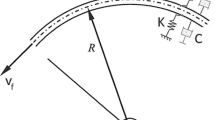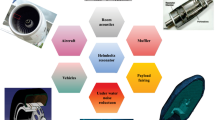Abstract
This article intends to examine thermoelastic damping (TED) in circular cylindrical nanoshells by considering small-scale effect on both structural and thermal areas. To fulfill this aim, governing equations are extracted with the aid of nonlocal elasticity theory and dual-phase-lag (DPL) heat conduction model. Circular cylindrical shell is also modeled on the basis of Donnell–Mushtari–Vlasov (DMV) equations for thin shells. By inserting asymmetric simple harmonic oscillations of nanoshell into motion, compatibility and heat conduction equations, the size-dependent thermoelastic frequency equation is obtained. By solving this equation and deriving the frequency of nanoshell affected by thermoelastic coupling, the value of TED can be calculated through complex frequency approach. Results of this investigation are given in two sections. First, to appraise the validity of presented formulation, a comparison study is conducted between the results of this work in special cases and those reported in the literature. Next, by providing several numerical data, a detailed parametric study is performed to highlight the profound impact of nonlocality and dual-phase-lagging on TED value in simply supported cylindrical nanoshells. The influence of some determining factors such as mode number and type of material on TED is also evaluated.







Similar content being viewed by others
References
Fleck NA, Muller GM, Ashby MF, Hutchinson JW. Strain gradient plasticity: theory and experiment. Acta Metall Mater. 1994;42(2):475–87.
Ma Q, Clarke DR. Size dependent hardness of silver single crystals. J Mater Res. 1995;10(4):853–63.
McFarland AW, Colton JS. Role of material microstructure in plate stiffness with relevance to microcantilever sensors. J Micromech Microeng. 2005;15(5):1060.
Toupin RA. Theories of elasticity with couple-stress. Arch Ration Mech Anal. 1964;17(2):85–112.
Eringen AC. Linear theory of nonlocal elasticity and dispersion of plane waves. Int J Eng Sci. 1972;10(5):425–35.
Yang FACM, Chong ACM, Lam DCC, Tong P. Couple stress based strain gradient theory for elasticity. Int J Solids Struct. 2002;39(10):2731–43.
Lam DC, Yang F, Chong ACM, Wang J, Tong P. Experiments and theory in strain gradient elasticity. J Mech Phys Solids. 2003;51(8):1477–508.
Xu M, Li X. The modeling of nanoscale heat conduction by Boltzmann transport equation. Int J Heat Mass Transf. 2012;55(7–8):1905–10.
Lord HW, Shulman Y. A generalized dynamical theory of thermoelasticity. J Mech Phys Solids. 1967;15(5):299–309.
Tzou DY. Macro-to microscale heat transfer: the lagging behavior. John Wiley & Sons; 2014.
Guyer RA, Krumhansl JA. Solution of the linearized phonon Boltzmann equation. Phys Rev. 1966;148(2):766.
Zener C. Internal friction in solids I Theory of internal friction in reeds. Phys Rev. 1937;52(3):230.
Lifshitz R, Roukes ML. Thermoelastic damping in micro-and nanomechanical systems. Phys Rev B. 2000;61(8):5600.
Lu P, Lee HP, Lu C, Chen HB. Thermoelastic damping in cylindrical shells with application to tubular oscillator structures. Int J Mech Sci. 2008;50(3):501–12.
Kim SB, Kim JH. Quality factors for the nano-mechanical tubes with thermoelastic damping and initial stress. J Sound Vib. 2011;330(7):1393–402.
Li P, Fang Y, Hu R. Thermoelastic damping in rectangular and circular microplate resonators. J Sound Vib. 2012;331(3):721–33.
Yue X, Yue X, Borjalilou V. Generalized thermoelasticity model of nonlocal strain gradient Timoshenko nanobeams. Arch Civil Mech Eng. 2021;21(3):1–20.
Xiao C, Zhang G, Hu P, Yu Y, Mo Y, Borjalilou V. Size-dependent generalized thermoelasticity model for thermoelastic damping in circular nanoplates. Waves Random Complex Media 2021; 1–21.
Li F, Esmaeili S. On thermoelastic damping in axisymmetric vibrations of circular nanoplates: incorporation of size effect into structural and thermal areas. Eur Phys J Plus. 2021;136(2):1–17.
Zhong ZY, Zhang WM, Meng G, Wang MY. Thermoelastic damping in the size-dependent microplate resonators based on modified couple stress theory. J Microelectromech Syst. 2014;24(2):431–45.
Zhang H, Kim T, Choi G, Cho HH. Thermoelastic damping in micro-and nanomechanical beam resonators considering size effects. Int J Heat Mass Transf. 2016;103:783–90.
Zhang C, Wang L, Eyvazian A, Khan A, Sebaey TA, Farouk N. Analytical study of the damping vibration behavior of the metal foam nanocomposite plates reinforced with graphene oxide powders in thermal environments. Arch Civil Mech Eng. 2021;21(4):1–23.
Parayil DV, Kulkarni SS, Pawaskar DN. A generalized model for thermoelastic damping in beams with mid-plane stretching nonlinearity. Int J Mech Sci. 2018;135:582–95.
Deng W, Li L, Hu Y, Wang X, Li X. Thermoelastic damping of graphene nanobeams by considering the size effects of nanostructure and heat conduction. J Therm Stress. 2018;41(9):1182–200.
Rashahmadi S, Meguid SA. Modeling size-dependent thermoelastic energy dissipation of graphene nanoresonators using nonlocal elasticity theory. Acta Mech. 2019;230(3):771–85.
Li SR, Ma HK. Analysis of free vibration of functionally graded material micro-plates with thermoelastic damping. Arch Appl Mech. 2020;90:1285–304.
Kumar H, Mukhopadhyay S. Thermoelastic damping analysis for size-dependent microplate resonators utilizing the modified couple stress theory and the three-phase-lag heat conduction model. Int J Heat Mass Transf. 2020;148:118997.
Yang Z, Cheng D, Cong G, Jin D, Borjalilou V. Dual-phase-lag thermoelastic damping in nonlocal rectangular nanoplates. Waves Random Complex Media 2021;1–20.
Ahmadi HR, Rahimi Z, Sumelka W. Thermoelastic damping in orthotropic and isotropic NEMS resonators accounting for double nonlocal thermoelastic effects. J Therm Stress. 2020;44(3):342–58.
Shi S, He T, Jin F. Thermoelastic damping analysis of size-dependent nano-resonators considering dual-phase-lag heat conduction model and surface effect. Int J Heat Mass Transf. 2021;170:120977.
Zhou H, Li P. Nonlocal dual-phase-lagging thermoelastic damping in rectangular and circular micro/nanoplate resonators. Appl Math Model. 2021;95:667–87.
Ge X, Li P, Fang Y, Yang L. Thermoelastic damping in rectangular microplate/nanoplate resonators based on modified nonlocal strain gradient theory and nonlocal heat conductive law. J Therm Stress. 2021;44(6):1–30.
Weng W, Lu Y, Borjalilou V. Size-dependent thermoelastic vibrations of Timoshenko nanobeams by taking into account dual-phase-lagging effect. Eur Phys J Plus. 2021;136(7):1–26.
Zhou H, Li P. Dual-phase-lagging thermoelastic damping and frequency shift of micro/nano-ring resonators with rectangular cross-section. Thin Wall Struct. 2021;159:107309.
Arshid E, Arshid H, Amir S, Mousavi SB. Free vibration and buckling analyses of FG porous sandwich curved microbeams in thermal environment under magnetic field based on modified couple stress theory. Arch Civil Mech Eng. 2021;21(1):1–23.
Soedel W, Qatu MS. Vibrations of shells and plates. New York: Dekker; 2005.
Borjalilou V, Asghari M. Thermoelastic damping in strain gradient microplates according to a generalized theory of thermoelasticity. J Therm Stress. 2020;43(4):401–20.
Borjalilou V, Asghari M, Taati E. Thermoelastic damping in nonlocal nanobeams considering dual-phase-lagging effect. J Vib Control. 2020;26(11–12):1042–53.
Acknowledgements
The study was supported by Heilongjiang Provincial Natural Science Foundation of China (LC2017028), Basic Scientific Research Business Expense Research Project of Heilongjiang Provincial Colleges and Universities (135409102), and Academic Backbone Project of Heilongjiang Provincial Department of Education (135509413).
Author information
Authors and Affiliations
Corresponding author
Ethics declarations
Conflict of interest
The authors declare that they have no conflict of interest.
Ethical approval
This article does not contain any studies with human participants or animals performed by any of the authors.
Additional information
Publisher's Note
Springer Nature remains neutral with regard to jurisdictional claims in published maps and institutional affiliations.
Appendix
Appendix
The free vibration of a nonlocal Euler–Bernoulli beam is governed by the following equation:
in which \(I\) and \(A\) represent the area moment of inertia of cross sections and cross section area of the beam. By adopting simple harmonic form \(w\left(x,t\right)={\sum }_{m=1}^{\infty }{W}_{m}(x){\mathrm{e}}^{i{\omega }_{m}t}\), substituting it into equation above, and simplifying the result, one can get:
where
The general solution of Eq. (60) has the following form:
in which \({C}_{1}\), \({C}_{2}\), \({C}_{3}\) and \({C}_{4}\) are integration constants. Substitution of relation above into Eq. (60) and solving the obtained equation gives:
Boundary conditions of three common types of beams, namely doubly simply supported (SS), doubly clamped (CC) and cantilever (CF) are expressed by [38]:
By inserting Eq. (62) into Eqs. (64)–(66), using Eq. (61) and setting the determinant of the coefficient matrix of the obtained algebraic equations for \({C}_{1}\), \({C}_{2}\), \({C}_{3}\) and \({C}_{4}\) to zero, one can attain the following characteristic equations:
By considering the relation of \({\gamma }_{1}\) and \({\gamma }_{2}\) with \({\lambda }_{m}\) through relation (63) and solving the equations above, \({\gamma }_{1}\) and \({\gamma }_{2}\) are extracted, and by inserting them in Eq. (62), the mode shape of nonlocal beams with mentioned boundary conditions is obtained. Since the model of Lu et al. [14] has been provided in the context of classical continuum theory (i.e. \(\mu =0\)) for CC boundary conditions, according to Eq. (63), the comparison study must be conducted on the basis of \({\gamma }_{1}={\gamma }_{2}={\lambda }_{m}\). Hence, by considering Eq. (68), the characteristic equation of a classical CC beam becomes:
On the other hand, by imposing boundary conditions (65) on Eq. (62) and letting \(\gamma_{1} = \gamma_{2} = \lambda_{m}\), the mode shape of a classical CC beam is obtained as follows:
Rights and permissions
About this article
Cite this article
Li, M., Cai, Y., Bao, L. et al. Analytical and parametric analysis of thermoelastic damping in circular cylindrical nanoshells by capturing small-scale effect on both structure and heat conduction. Archiv.Civ.Mech.Eng 22, 14 (2022). https://doi.org/10.1007/s43452-021-00330-3
Received:
Revised:
Accepted:
Published:
DOI: https://doi.org/10.1007/s43452-021-00330-3




